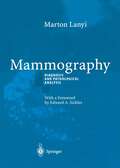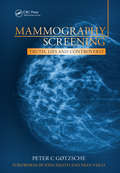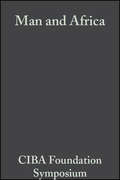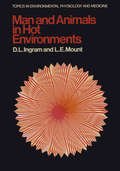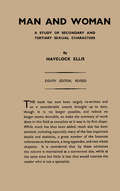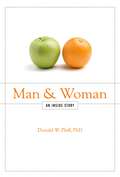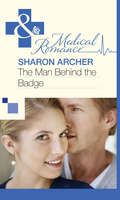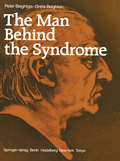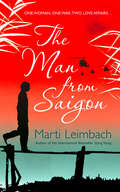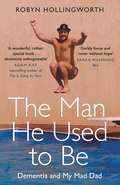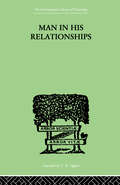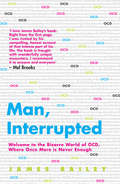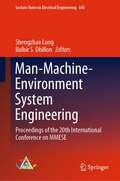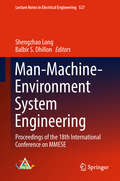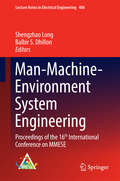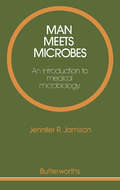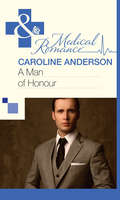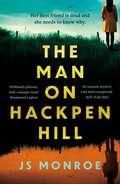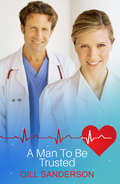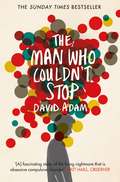- Table View
- List View
Mammography: Diagnosis and Pathological Analysis
by Marton LanyiAn explanation of modern breast pathology aimed at physicians practicing mammography. Mammography can be thought of as a (sub)macroscopic "shadow pathology" - confident diagnosis necessitates comprehensive knowledge of breast pathology. The traditional rules of thumb, for example that a regular, rounded shadow means a benign lesion, a radiating structure represents a malignant tumor, and microcalcification indicates biopsy, no longer hold true. The over 600 individual illustrations and more than 1,000 references help the reader understand breast morphology. The book is rounded off by a detailed description of the clinical symptoms and a helpful summary of the supplementary diagnostic procedures and the possibilities for treatment.
Mammography: Guide to Interpreting, Reporting and Auditing Mammographic Images - Re.Co.R.M. (From Italian Reporting and Codifying the Results of Mammography)
by V. Lattanzio G. SimonettiBreast cancer screening by mammography has proved to be the only means of reducing mortality from this disease by as much as 30-50% worldwide. However, despite the widespread utilization of screening mammography and the constantly growing number of examinations performed every day, the interpretation of mammograms remains largely subjective and is not even always clear. The current terminology is still far from standardized and is often even inappropriate. This is partly because of a lack of complete knowledge of mammographic signs and how to report them in clear, correct language. The core of this book consists of high-quality images that clearly demonstrate normal breast features and pathologic abnormalities, thus providing essential visual support for radiologists interpreting mammograms.
Mammography Screening: Truth, Lies and Controversy
by Peter Gotzsche'This book gives plenty of examples of ad hominem attacks, intimidation, slander, threats of litigation, deception, dishonesty, lies and other violations of good scientific practice. For some years I kept a folder labeled Dishonesty in breast cancer screening on top of my filing cabinet, storing articles and letters to the editor that contained statements I knew were dishonest. Eventually I gave up on the idea of writing a paper about this collection, as the number of examples quickly exceeded what could be contained in a single article.' From the Introduction The most effective way to decrease women's risk of becoming a breast cancer patient is to avoid attending screening. Mammography screening is one of the greatest controversies in healthcare, and the extent to which some scientists have sacrificed sound scientific principles in order to arrive at politically acceptable results in their research is extraordinary. In contrast, neutral observers increasingly find that the benefit has been much oversold and that the harms are much greater than previously believed. This groundbreaking book takes an evidence-based, critical look at the scientific disputes and the information provided to women by governments and cancer charities. It also explains why mammography screening is unlikely to be effective today. All health professionals and members of the public will find these revelations disturbingly illuminating. It will radically transform the way healthcare policy makers view mammography screening in the future. 'If Peter Gotzsche did not exist, there would be a need to invent him ...It may still take time for the limitations and harms of screening to be properly acknowledged and for women to be enabled to make adequately informed decisions. When this happens, it will be almost entirely due to the intellectual rigour and determination of Peter Gotzsche.' From the Foreword by Iona Heath, President, RCGP 'If you care about breast cancer, and we all should, you must read this book. Breast cancer is complex and we cannot afford to rely on the popular media, or on information from marketing campaigns from those who are invested in screening. We need to question and to understand. The story that Peter tells matters very much.' From the Foreword by Fran Visco, President, National Breast Cancer Coalition
Mammography Screening: Truth, Lies and Controversy
by Peter Gotzsche'This book gives plenty of examples of ad hominem attacks, intimidation, slander, threats of litigation, deception, dishonesty, lies and other violations of good scientific practice. For some years I kept a folder labeled Dishonesty in breast cancer screening on top of my filing cabinet, storing articles and letters to the editor that contained statements I knew were dishonest. Eventually I gave up on the idea of writing a paper about this collection, as the number of examples quickly exceeded what could be contained in a single article.' From the Introduction The most effective way to decrease women's risk of becoming a breast cancer patient is to avoid attending screening. Mammography screening is one of the greatest controversies in healthcare, and the extent to which some scientists have sacrificed sound scientific principles in order to arrive at politically acceptable results in their research is extraordinary. In contrast, neutral observers increasingly find that the benefit has been much oversold and that the harms are much greater than previously believed. This groundbreaking book takes an evidence-based, critical look at the scientific disputes and the information provided to women by governments and cancer charities. It also explains why mammography screening is unlikely to be effective today. All health professionals and members of the public will find these revelations disturbingly illuminating. It will radically transform the way healthcare policy makers view mammography screening in the future. 'If Peter Gotzsche did not exist, there would be a need to invent him ...It may still take time for the limitations and harms of screening to be properly acknowledged and for women to be enabled to make adequately informed decisions. When this happens, it will be almost entirely due to the intellectual rigour and determination of Peter Gotzsche.' From the Foreword by Iona Heath, President, RCGP 'If you care about breast cancer, and we all should, you must read this book. Breast cancer is complex and we cannot afford to rely on the popular media, or on information from marketing campaigns from those who are invested in screening. We need to question and to understand. The story that Peter tells matters very much.' From the Foreword by Fran Visco, President, National Breast Cancer Coalition
Man and Africa (Novartis Foundation Symposia #966)
by G. E. W. Wolstenholme Maeve O'ConnorThe Novartis Foundation Series is a popular collection of the proceedings from Novartis Foundation Symposia, in which groups of leading scientists from a range of topics across biology, chemistry and medicine assembled to present papers and discuss results. The Novartis Foundation, originally known as the Ciba Foundation, is well known to scientists and clinicians around the world.
Man and Animals in Hot Environments (Topics in Environmental Physiology and Medicine)
by D.L. Ingram L.E. MountMan and Woman: A Study of Secondary and Tertiary Sexual Characters
by Havelock EllisMan and Woman: A Study of Secondary and Tertiary Sexual Characters, Eight Edition Revised covers the developments of biological investigation of male and female sexual characteristics. This 16-chapter book specifically considers the radical and essential characters of men and women uninfluenced by external modifying conditions. This book starts with an introduction to the boundary between secondary and tertiary sexual characters. The subsequent chapters examine some of the measurable sex differences in terms of metabolism, the viscera, the growth and body proportions, and the senses. Other chapters describe the anatomical distinction between sexes, including the pelvis and the head. A chapter highlights the phenomena of menstruation of women. The discussion then shifts to tertiary sexual character determinants, such as motion, unconscious state, emotion, and artistic and intellectual impulse. The final chapters tackle the issue of variational tendency in men and women. These chapters also provide a summary of what is known about sexual character distinction. Psychologists, psychiatrists, endocrinologists, and development biologists will find this book rewarding.
Man and Woman: An Inside Story
by Donald W. Pfaff, PhDThe saga of sex differences in brain and behavior begins with a tiny sperm swimming toward a huge egg, to contribute its tiny Y chromosome plus its copies of the other chromosomes. Genetic, anatomic and physiologic alterations in the male ensue, making his brain and behavior different in specific respects from his sister. Brain-wise, specific cell groups develop differently in males compared to females, in some cases right after birth and in other cases at puberty. But genetics and neuroanatomy do not dominate the scene. Prenatal stress, postnatal stress and lousy treatment at puberty all can affect males and females in different ways. The upshot of all these genetic and environmental factors produces small sex differences in certain abilities and huge sex differences in feelings, in pain and in suffering. Put this all together and the reader will see that biological and cultural influences on gender roles operate at so many different levels to influence behavioral mechanisms that gender role choices are flexible, reversible and non-dichotomous, especially in modern societies.
Man and Woman: An Inside Story
by Donald W. Pfaff, PhDThe saga of sex differences in brain and behavior begins with a tiny sperm swimming toward a huge egg, to contribute its tiny Y chromosome plus its copies of the other chromosomes. Genetic, anatomic and physiologic alterations in the male ensue, making his brain and behavior different in specific respects from his sister. Brain-wise, specific cell groups develop differently in males compared to females, in some cases right after birth and in other cases at puberty. But genetics and neuroanatomy do not dominate the scene. Prenatal stress, postnatal stress and lousy treatment at puberty all can affect males and females in different ways. The upshot of all these genetic and environmental factors produces small sex differences in certain abilities and huge sex differences in feelings, in pain and in suffering. Put this all together and the reader will see that biological and cultural influences on gender roles operate at so many different levels to influence behavioral mechanisms that gender role choices are flexible, reversible and non-dichotomous, especially in modern societies.
The Man Behind the Badge (Mills And Boon Medical Ser.)
by Sharon ArcherHowever hard citygirl and newdocintown Kayla Morgan tries, she can’t resist being impressed by the horseriding, cattleherding, lawenforcing Tom Jamieson! But taking a bullet in the line of duty has made cop Tom rethink his work hard, party harder lifestyle – will he ever let Kayla see the real man behind the badge?
The Man Behind the Syndrome
by Peter Beighton Greta BeightonThe Man Behind the Syndrome by my friends and colleagues Peter and Greta Beighton is a delightful book which will be read eagedy and with keen intellectual pleasure by all human, medical, and dinical genetieists. The reader with a historical tum of mind will note right away that the book achieyes more than the usual entry in a dictionary of seientific biography. In addition to the standard professional data, it gives a photo and some personal glimpses of the man, allowing the reader to appreeiate his human qualities as weIl. This volume contains, so to speak, the creme de la creme, namely, those in a group whose names are daily on the lips of every practicing dinical geneticist. This interesting and instructive book is commended to all in medical genetics and the history of medieine with the highest enthusiasm and gratitude to its authors for undertaking this labor of love. A second volume is planned for more recently delineated disorders for which an eponym is not yet widely used.
The Man from Saigon: A Novel
by Marti Leimbach"After all the stories of battles and deaths, of torture and loss and hatred, someone should tell this one, too, about a man who moved among them, who seemed to love them."
The Man He Used To Be: Dementia and My Mad Dad
by Robyn Hollingworth'This is a wonderful, rather special book: funny, warm and loving but also thought-provoking and deeply moving. Absolutely unforgettable - ironically.'ADAM KAY, Sunday Times bestselling author of This Is Going To HurtInadvertent cross-dressing. Attempted murder. Jail break. A waltz at a funeral. A hernia the size of Guernsey.Heartbreaking and darkly comic, these are the moments that litter the messy road from cared-for to carer, a journey that Robyn Hollingworth finds herself on when she's only twenty-five years old. Leaving London to return home to rural South Wales, Robyn finds that it's her old life - same teddy bears resting on her pillow, their bodies tucked under the duvet; same view of the garages behind which she'd had her first cigarette and first kiss - but so much has changed. Her dad, the proud, charmingly intelligent, self-made man who made people laugh, is in the grip of early onset Alzheimer's. His brilliant mind, which saw him building power stations and literally bringing light into the lives of others, has succumbed to darkness. As Robyn settles back in the rhythms of life in the rain-soaked vast Welsh valleys, she keeps a diary charting her journey as the dad she knew disappears before her eyes. Lyrical, poignant and with flashes of brilliant humour, The Man He Used To Be explores how in helping others we can heal ourselves. Previously published in hardback as My Mad Dad.
Man In His Relationships
by H. WestmannThis is Volume VI of six in a collection on Psychology and Religion. Originally published in 1955, Man and his relationships was the theme of the tenth Present Question Conference which was held at Lady Margaret Hall, Oxford in July 1954. This raised the question ‘Can both Answer and Question be found by putting one fundamental problem in the centre, towards which, like the petals of a flower, each specialized field of human knowledge gives its contribution?' This work attempts to see more clearly that the fundamental human problem of modem society is in fact the integration of diversity of experience-the bridging of the gap between specialisms.
Man In His Relationships
by H. WestmannThis is Volume VI of six in a collection on Psychology and Religion. Originally published in 1955, Man and his relationships was the theme of the tenth Present Question Conference which was held at Lady Margaret Hall, Oxford in July 1954. This raised the question ‘Can both Answer and Question be found by putting one fundamental problem in the centre, towards which, like the petals of a flower, each specialized field of human knowledge gives its contribution?' This work attempts to see more clearly that the fundamental human problem of modem society is in fact the integration of diversity of experience-the bridging of the gap between specialisms.
Man, Interrupted: Welcome to the Bizarre World of OCD, Where Once More is Never Enough
by James BaileyJames Bailey's form of obsessive-compulsive disorder (OCD) was as bizarre as it was unbearable. He was obsessed by a fear of drugs and their effects, believing himself to be in constant danger of becoming insanely high through people spiking his food, or even by just touching a photograph of a marijuana leaf.The treatment programme he went through at a specialist American clinic was challenging, to say the least. He was asked to shake hands and mingle with the local junkies, fighting his anxieties and the urge to go and wash for as long as possible in order to 'expose' himself to his fears.Man, Interrupted gives us a glimpse into the tortured world of a man suffering from what is an increasingly common disorder. But far from being a doom-laden account of mental illness, the result is uniquely revealing, hilariously entertaining and wonderfully rewarding.
Man-Machine-Environment System Engineering: Proceedings of the 20th International Conference on MMESE (Lecture Notes in Electrical Engineering #645)
by Balbir S. Dhillon Shengzhao LongThis book presents selected papers introducing readers to the key research topics and latest development trends in the theory and application of MMESE. The advanced integrated research topic man-machine-environment system engineering (MMESE) was first established in China by Professor Shengzhao Long in 1981, with direct support from one of the greatest modern Chinese scientists, Xuesen Qian. In a letter to Shengzhao Long from October 22nd, 1993, Xuesen Qian wrote: “You have created a very important modern science and technology in China!”MMESE primarily focuses on the relationship between man, machine and environment, studying the optimum combination of man-machine-environment systems, where “man” refers to people in the workplace (e.g., operators, decision-makers), “machine” is the general name for any object controlled by man (including tools, machinery, computers, systems and technologies), and “environment” describes the specific working conditions under which man and machine interact (e.g., temperature, noise, vibration and hazardous gases). The three goals of optimizing such systems are ensuring safety, efficiency and economy.Presenting interdisciplinary studies on the concepts and methods in physiology, psychology, system engineering, computer science, environmental science, management, education and other related disciplines, this book is a valuable resource for all researchers and professionals whose work involves MMESE subjects.
Man-Machine-Environment System Engineering: Proceedings of the 18th International Conference on MMESE (Lecture Notes in Electrical Engineering #527)
by Shengzhao Long Balbir S. DhillonThese proceedings showcase the best papers selected from more than 500 submissions, and introduce readers to the hottest research topics and the latest developmental trends in the theory and application of MMESE. The integrated and advanced science research topic Man-Machine-Environment System Engineering (MMESE) was first established in China by Professor Shengzhao Long in 1981, with direct support from one of the greatest modern Chinese scientists, Xuesen Qian. In a letter to Long from October 22nd, 1993, Qian wrote: “You have created a very important modern science and technology in China!” MMESE primarily focuses on the relationship between Man, Machine and Environment, studying the optimum combination of man-machine-environment systems. In this system, “Man” refers to working people as the subject in the workplace (e.g. operators, decision-makers); “Machine” is the general name for any object controlled by Man (including tools, machinery, computers, systems and technologies), and “Environment” describes the specific working conditions under which Man and Machine interact (e.g. temperature, noise, vibration, hazardous gases etc.). The three main goals of optimizing man-machine-environment systems are to ensure safety, efficiency and economy. These proceedings present interdisciplinary studies on essential concepts and methods from physiology, psychology, system engineering, computer science, environmental science, management, education, and other related disciplines. As such, they offer a valuable resource for all researchers and professionals whose work involves interdisciplinary areas touching on MMESE subjects.
Man-Machine-Environment System Engineering: Proceedings of the 16th International Conference on MMESE (Lecture Notes in Electrical Engineering #406)
by Shengzhao Long Balbir S. DhillonThis research topic was first established in China by Professor Shengzhao Long in 1981, with direct support from one of the greatest modern Chinese scientists, Xuesen Qian. In a letter to Shengzhao Long from October 22nd, 1993, Xuesen Qian wrote: “You have created a very important modern science subject and technology in China!”MMESE primarily focuses on the relationship between Man, Machine and Environment, studying the optimum combination of man-machine-environment systems. In this system, “Man” refers to working people as the subject in the workplace (e.g. operators, decision-makers); “Machine” is the general name for any object controlled by Man (including tools, machinery, computers, systems and technologies), and “Environment” describes the specific working conditions under which Man and Machine interact (e.g. temperature, noise, vibration, hazardous gases etc.). The three goals of optimization are to ensure "Safety, High efficiency and Economy" of man-machine-environment systems.These proceedings are an academic showcase of the best papers selected from more than 400 submissions, introducing readers to the top research topics and the latest developmental trends in the theory and application of MMESE.These proceedings are interdisciplinary studies on the concepts and methods of physiology, psychology, system engineering, computer science, environment science, management, education, and other related disciplines. Researchers and professionals who study an interdisciplinary subject crossing above disciplines or researchers on MMESE subject will be mainly benefited from these proceedings.
Man Meets Microbes: An Introduction to Medical Microbiology
by Jennifer R. JamisonMan meets Microbes: An Introduction to Medical Microbiology is concerned with the infective aspects of disease in man. It considers the role of organisms in causing disease and also with the response to, and defense of man against these organisms.The book begins with a general introduction, providing a survey of the history of microbiology and a classification of micro-organisms and parasites capable of causing disease in man. Subsequent chapters are devoted to discussions on such topics as host-parasite relationships, parasites, bacteria and viruses, and organ systems and how they get infected with disease. The final chapter covers certain topics such as infection during pregnancy, fever, and nursing being a hazardous occupation.Microbiologists and those in the medical profession will find the book very useful.
A Man of Honour: Dangerous Sanctuary / The Heat Of Passion / Darker Side Of Desire / A Man Of Honour (The Audley #10)
by Caroline AndersonTHE DOCTOR’S SECRET
The Man on Hackpen Hill
by J.S. Monroe'Brilliantly plotted, with a seismic twist' Rosamund LuptonHer best friend is dead and she needs to know why.Aspiring journalist Bella is on work experience at a national newspaper when, out of the blue, she receives an anonymous letter promising her a big scoop if she travels down to Wiltshire.All she finds is a government scientist spouting conspiracy theories in the pub. But then Bella's best friend Erin is found dead in a nearby field, her body staged in the centre of a crop circle. Bella is devastated. Is this the real reason she was lured out here?While detective Silas Hart searches for evidence, Bella scours her own memory for clues. But it's full of blanks – the details of her university days with Erin keep slipping away. What secrets was Erin hiding? And, once they're uncovered, what will it mean for Bella?Praise for The Man on Hackpen Hill:'An impressive, twisty tale' Independent 'Impeccably researched... An unusual mystery told with exceptional skill' Daily Mail 'A kind of Wiltshire Da Vinci Code... A real page turner' Tom Bradby
The Man She Could Never Forget: The Man She Could Never Forget / The Nurse Who Stole His Heart (Wildfire Island Docs #1)
by Meredith WebberReunion on Wildfire Island
A Man to be Trusted: A Medical Romance (A\medical Romance Ser.)
by Gill SandersonSue McCain, newly qualified as a midwife, found her work satisfying. But she carried too much baggage to be completely at ease socially these days. That didn’t matter to the Obs & Gynae Registrar, Dan Webster. He wanted to get to know her, and he clearly wasn’t going to allow himself to befrozen out! He even persuaded her to help with a concert he was organising for the hospital. But it brought her past and her present face to face, and only Dan’s support and love helped her cope …
The Man Who Couldn't Stop: The Truth About OCD
by David AdamA Sunday Times Bestseller Have you ever had a strange urge to jump from a tall building, or steer your car into oncoming traffic? You are not alone. In this captivating fusion of science, history and personal memoir, writer David Adam explores the weird thoughts that exist within every mind, and how they drive millions of us towards obsessions and compulsions. David has suffered from OCD for twenty years, and The Man Who Couldn't Stop is his unflinchingly honest attempt to understand the condition and his experiences. What might lead an Ethiopian schoolgirl to eat a wall of her house, piece by piece; or a pair of brothers to die beneath an avalanche of household junk that they had compulsively hoarded? At what point does a harmless idea, a snowflake in a clear summer sky, become a blinding blizzard of unwanted thoughts? Drawing on the latest research on the brain, as well as historical accounts of patients and their treatments, this is a book that will challenge the way you think about what is normal, and what is mental illness. Told with fierce clarity, humour and urgent lyricism, this extraordinary book is both the haunting story of a personal nightmare, and a fascinating doorway into the darkest corners of our minds.
